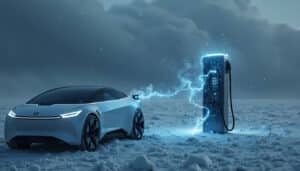« `html
Winter’s cold grip has long been a thorn in the side of electric vehicle enthusiasts.Charging an EV in frigid temperatures used to feel like waiting for your coffee to brew in Antarctica.But science is flipping the script on chilly charging woes.
Recent advancements in lithium-ion battery technology are set to revolutionize how electric vehicles perform during the coldest months. Scientists have discovered a way to quintuple charge speeds even at temperatures as low as -10°C by reimagining battery design. By laser-drilling microscopic ‘channels’ into the anode’s graphite layers, they’ve accelerated the flow of lithium ions, ensuring faster energy transfer. To counteract unwanted lithium deposition, a thin layer of lithium borate-carbonate is applied, drastically enhancing charging efficiency. This innovative approach not only preserves battery capacity through numerous rapid charge cycles but also integrates seamlessly with current manufacturing processes. The result? Electric vehicles that maintain their vigor and reliability, no matter how frosty the weather outside.

Table of contents
Togglehow does extreme cold affect ev battery charging?
When temperatures plummet, electric vehicles face significant challenges, particularly concerning battery performance. In extreme cold, such as -10°C, the lithium-ion batteries that power these vehicles undergo notable physical and chemical changes that impede their functionality. Cold weather causes the liquid electrolyte within the battery to thicken, effectively slowing down the movement of lithium ions between the electrodes. This sluggish ion movement results in a reduced current flow, which not only prolongs the charging time but also diminishes the overall efficiency of the battery.
Moreover, the cold environment adversely affects the chemical reactions necessary for optimal battery performance. At lower temperatures, the kinetics of these reactions slow down, leading to decreased energy efficiency. This is why electric vehicles often exhibit reduced range and longer charging times during winter months. Traditional solutions, such as increasing the thickness of the electrodes, have been attempted to counteract these effects. However, these methods frequently exacerbate the problem by further limiting the battery’s ability to support rapid charging.
Understanding the detrimental impact of extreme cold on battery performance is crucial for advancing electric vehicle technology. It highlights the need for innovative solutions that can maintain or even enhance battery efficiency under such challenging conditions. Addressing these issues not only improves the user experience for EV owners in colder regions but also contributes to the broader adoption of electric vehicles by making them more reliable year-round.
what is the new innovation in lithium-ion battery design?
In the quest to overcome the limitations posed by extreme cold, scientists have introduced a groundbreaking innovation in the design of lithium-ion batteries. This advancement focuses on modifying the structural components of the battery to enhance its performance in low temperatures. Published in the reputable journal Joule, the study details a novel approach that combines structural modifications with precise chemical adjustments during the charging process.
The core of this innovation lies in the strategic alteration of the battery’s anode structure. By creating tiny channels or ‘paths’ through the graphite layers of the anode using advanced laser technology, researchers have effectively accelerated the movement of lithium ions. This modification addresses the primary issue caused by cold temperatures—the sluggish ion mobility—thereby significantly reducing the charging time for electric vehicles.
Additionally, the innovation incorporates a thin coating of lithium borate-carbonate on the battery. This material is renowned for its ability to enhance the efficiency of solid-state batteries, and in this application, it plays a crucial role in preventing the undesirable deposition of lithium during the charging process in cold conditions. The combined effect of these structural and chemical tweaks results in a remarkable increase in charging efficiency, enabling electric vehicles to charge up to six times faster even in harsh winter climates.
This breakthrough not only addresses the immediate challenges associated with battery performance in cold weather but also paves the way for more resilient and efficient energy storage solutions. Such advancements are essential for the widespread adoption of electric vehicles, particularly in regions that experience severe winters.
how does laser-punched anode structure improve charging speed?
The introduction of a laser-punched anode structure represents a significant leap forward in enhancing the charging speed of electric vehicle batteries under extreme cold conditions. This innovative technique involves using a laser to meticulously drill holes or create pathways within the graphite layers of the battery’s anode. These channels are not merely aesthetic; they serve a critical functional purpose by facilitating the swift movement of lithium ions across the anode during the charging process.
In traditional lithium-ion batteries, the anode’s graphite layers can become a bottleneck for ion movement, especially at low temperatures where the electrolyte becomes more viscous. The laser-punched pathways effectively reduce the resistance encountered by the ions, allowing them to traverse the anode more freely and rapidly. This enhancement directly translates to faster charging times, addressing one of the most pressing drawbacks of electric vehicles—long wait times at charging stations.
However, this modification alone presented its own set of challenges. Earlier implementations of laser-punched anodes, such as those tested in 2020, showed promise in accelerating ion movement but led to unintended lithium deposition when used in cold environments. This deposition not only hampers the battery’s efficiency but can also reduce its overall lifespan.
To mitigate this issue, researchers combined the laser-punched anode structure with the application of a lithium borate-carbonate coating. This dual approach ensures that while the anode’s improved design facilitates faster ion movement, the protective coating prevents the adverse effects of lithium deposition. The result is a battery that can charge significantly faster without compromising its durability or performance.
This innovative anode design exemplifies how targeted structural modifications can overcome specific environmental challenges, making electric vehicles more adaptable and efficient in diverse climates.
what role does lithium borate-carbonate play in preventing lithium deposition?
The application of lithium borate-carbonate in the newly designed lithium-ion batteries constitutes a pivotal element in enhancing battery performance under extreme cold conditions. This compound is renowned for its efficacy in improving the efficiency and stability of solid-state batteries, and its incorporation into the innovative battery design serves multiple critical functions.
One of the primary challenges with rapid charging in cold environments is the tendency for lithium ions to deposit on the anode’s surface, a phenomenon known as lithium deposition. This deposition can lead to the formation of lithium dendrites, which are needle-like structures that can pierce the battery’s separator, potentially causing short circuits and reducing the battery’s lifespan.
To address this, the researchers applied a thin layer of lithium borate-carbonate over the modified anode structure. This coating acts as a protective barrier, preventing the direct deposition of lithium ions onto the anode. By doing so, it ensures that the accelerated ion movement facilitated by the laser-punched pathways does not result in detrimental lithium buildup.
Moreover, lithium borate-carbonate enhances the overall charge efficiency of the battery. The study highlighted a staggering 500% increase in charging efficiency under cold conditions when this compound was utilized. This improvement is attributed to the compound’s ability to stabilize the chemical reactions within the battery, ensuring that a higher proportion of the electrical energy is effectively converted into chemical energy stored within the battery cells.
The durability of the modified batteries further underscores the importance of lithium borate-carbonate. After 100 cycles of rapid charging in freezing temperatures, the batteries retained 97% of their original capacity. This resilience not only extends the battery’s usable life but also ensures consistent performance, making electric vehicles more reliable and efficient for consumers.
Incorporating lithium borate-carbonate into battery design represents a sophisticated solution to the challenges of rapid charging in cold climates, balancing both performance enhancements and safety considerations.
what are the implications for electric vehicles in cold climates?
The advancements in lithium-ion battery technology, particularly the ability to charge six times faster in extreme cold, have profound implications for the future of electric vehicles, especially in regions that experience harsh winters. This innovation addresses one of the most significant barriers to widespread EV adoption in colder climates—reduced battery efficiency and prolonged charging times.
With the newly developed battery design, electric vehicles become more viable for users in cold regions. The enhanced charging speed means that drivers can quickly recharge their vehicles even in freezing temperatures, reducing the inconvenience and downtime associated with long charging periods. This improvement is particularly beneficial for those who rely on their vehicles for daily commutes or long-distance travel in cold weather.
Furthermore, the increased battery efficiency at low temperatures translates to better vehicle range during winter months. Traditionally, EVs have struggled with diminished range in cold weather due to the decreased performance of their batteries. The ability to maintain high efficiency and rapid charging in such conditions ensures that electric vehicles can compete more effectively with traditional internal combustion engine vehicles, which are typically less affected by temperature extremes.
From an environmental perspective, this innovation supports the broader goal of reducing carbon emissions by making electric vehicles a more practical and appealing option for a larger demographic. As more consumers feel confident in the reliability of EVs during all seasons, the transition away from fossil fuels accelerates, contributing to global sustainability efforts.
Additionally, infrastructure development for electric vehicles can be more confidently pursued in cold regions. The possibility of integrating high-speed charging solutions that function reliably in extreme temperatures opens up new markets and encourages investment in EV-related technologies. For instance, revolutionary highway charging technologies, like those discussed in this article, can be optimized to complement the enhanced battery performance, creating a seamless and efficient driving experience.
Moreover, this breakthrough could inspire further innovations in battery technology and energy storage, fostering a more resilient and adaptable electric vehicle ecosystem. Manufacturers can leverage these advancements to design next-generation batteries that are not only faster to charge but also more durable and efficient across a wider range of environmental conditions.
In summary, the ability to charge electric vehicles significantly faster in extreme cold conditions marks a transformative step forward, enhancing the practicality, reliability, and appeal of EVs in cold climates. This innovation not only benefits consumers but also supports the ongoing efforts to promote sustainable transportation solutions on a global scale.
how can manufacturers integrate these battery innovations?
The seamless integration of these pioneering battery innovations into existing manufacturing processes is a critical factor in their widespread adoption. According to Neil Dasgupta, a leading researcher in the field, the modifications required for this enhanced battery design can be easily incorporated into current production lines without necessitating significant overhauls or disruptions. This compatibility is a major advantage, as it allows manufacturers to adopt these advancements with minimal additional costs and downtime.
The process begins with the implementation of laser technology to create the ‘paths’ within the anode’s graphite layers. Modern battery manufacturing facilities are often equipped with advanced laser systems that can be adapted to perform this precise modification. The scalability of this process means that it can be applied to large-scale production without significantly slowing down the manufacturing timeline.
Following the structural modification, the application of the lithium borate-carbonate coating is a relatively straightforward step. This involves applying a thin, uniform layer of the compound over the anode, a process that can be integrated into existing coating stages within the battery assembly line. Given that lithium borate-carbonate is already recognized for its benefits in solid-state batteries, manufacturers are likely familiar with its handling and application, further simplifying the integration process.
Importantly, these modifications do not require changes to the fundamental architecture of electric vehicle batteries. This means that existing battery models can be upgraded with the new technology without the need for redesigning the overall battery system. The ability to retrofit current models with these enhancements ensures that manufacturers can quickly respond to the growing demand for more efficient and reliable batteries in cold climates.
Moreover, the durability of the modified batteries, as evidenced by the 97% capacity retention after 100 rapid charge cycles, means that these batteries offer long-term benefits. Manufacturers can market these batteries not only as faster-charging solutions but also as more durable and reliable options, providing a compelling value proposition to consumers.
By facilitating easier integration, this innovation empowers battery manufacturers and electric vehicle producers to swiftly adopt and leverage these advancements, accelerating the transition to more efficient and climate-resilient electric mobility solutions.
what potential does this innovation hold for future technologies?
The innovation that enables electric vehicles to charge six times faster in extreme cold conditions has far-reaching implications beyond just improving EV performance. This breakthrough in lithium-ion battery technology opens up a myriad of possibilities for future advancements in various sectors reliant on efficient energy storage and rapid charging capabilities.
One significant area of potential is the development of high-performance energy storage systems for renewable energy sources. As the world increasingly shifts towards sustainable energy, the demand for reliable and efficient storage solutions grows. The ability to rapidly charge batteries in diverse environmental conditions can enhance the viability of solar and wind energy systems, ensuring that energy can be stored and dispensed as needed, regardless of external temperatures.
Furthermore, this innovation could catalyze progress in portable electronic devices. Smartphones, laptops, and other gadgets could benefit from faster charging times without compromising battery longevity. The principles applied in EV batteries can be adapted to smaller-scale batteries, leading to more efficient and user-friendly consumer electronics.
The aerospace and aviation industries could also harness this technology to improve the performance and reliability of energy storage systems in aircraft and spacecraft. Batteries that maintain high efficiency in extreme cold are crucial for missions in space and high-altitude environments, where temperatures can vary drastically.
Additionally, the integration of lithium borate-carbonate coatings and laser-punched anode structures could inspire new designs in solid-state batteries, which are considered the next frontier in battery technology. These advancements could lead to batteries that are not only faster to charge but also safer and more stable, reducing the risks associated with thermal runaway and other safety concerns.
In the automotive sector, beyond passenger vehicles, this innovation can enhance the performance of electric buses, trucks, and even autonomous vehicles, which require robust and efficient energy storage solutions to operate reliably over long distances and under varying environmental conditions.
Ultimately, the ripple effects of this battery innovation extend into numerous fields, driving forward the efficiency, durability, and versatility of energy storage technologies. As industries continue to explore and adopt these advancements, the potential for creating a more sustainable and technologically advanced future becomes increasingly attainable.
explore more innovations in electric vehicle technology
The realm of electric vehicle technology is rapidly evolving, with numerous innovations pushing the boundaries of what is possible in sustainable transportation. From revolutionary charging solutions to cutting-edge battery enhancements, the industry is witnessing a transformation that promises to make electric mobility more efficient, accessible, and reliable than ever before.
One such exciting development is the highway charging technology that allows electric vehicles to charge on the move. This groundbreaking system integrates charging infrastructure directly into highways, enabling continuous power supply to moving vehicles. Such technology could drastically reduce charging times and mitigate range anxiety, making electric vehicles a more practical choice for long-distance travel.
Another noteworthy innovation is Google’s Android XR Glasses, which, while not directly related to electric vehicles, exemplify the cross-industry advancements spurred by cutting-edge research and development. The integration of advanced augmented reality (AR) and virtual reality (VR) technologies into everyday devices highlights the interconnectedness of various tech sectors and the potential for collaborative innovations.
Additionally, the recognition of innovative projects by various organizations underscores the importance of fostering creativity and research in technology development. For instance, teams that clinched innovation awards in Saint Nazaire demonstrate the tangible benefits of investing in unique and impactful projects. These accolades not only reward excellence but also inspire other innovators to pursue ambitious and transformative ideas.
In the automotive sector, French innovation has led to a significant breakthrough where the charging speed of the electric Megane has been doubled, showcasing the continuous efforts to enhance the performance and convenience of electric vehicles. Such advancements contribute to the broader goal of making electric mobility more efficient and user-friendly.
Moreover, the development of ultra-fast chargers, like the one featured in this article, which can power up smartphones in just five minutes, hints at the future possibilities for rapid charging across all battery-powered devices. These technologies share a common foundation with EV charging innovations, emphasizing the universal demand for faster and more efficient energy solutions.
Overall, the landscape of electric vehicle technology is vibrant and dynamic, with continuous innovations driving the industry forward. Staying informed about these developments is essential for enthusiasts, consumers, and industry stakeholders alike, as they navigate the exciting trajectory towards a more sustainable and technologically advanced future.
case study: french innovation doubles charging speed of the electric megane
A prime example of the tangible benefits of battery innovations can be seen in the recent advancements made by French engineers with the electric Megane. This electric vehicle has achieved a remarkable milestone by doubling its charging speed, a feat that directly correlates with the innovations discussed earlier. This case study highlights the practical application and real-world impact of improved lithium-ion battery designs.
The electric Megane, a flagship model in France’s push towards sustainable automotive technology, integrated the latest battery enhancements to achieve superior performance in cold conditions. By incorporating the laser-punched anode structure and the lithium borate-carbonate coating, the Megane’s battery can now charge in half the time previously required, even in sub-zero temperatures. This improvement not only enhances the user experience by reducing wait times but also extends the vehicle’s usability in regions with harsh winters.
Consumers have responded positively to this development, citing increased confidence in the vehicle’s reliability and efficiency during cold weather. The ability to maintain high charging efficiency and extended battery lifespan makes the electric Megane a more attractive option for a broader audience. Additionally, this innovation positions the Megane as a leader in the competitive EV market, setting a new standard for performance and reliability.
From a manufacturing perspective, the integration of these battery enhancements into the Megane was streamlined and cost-effective, affirming the feasibility of adopting such technologies on a large scale. This success story serves as a compelling argument for other manufacturers to invest in similar innovations, demonstrating that the benefits of faster charging and improved battery performance can be realized without substantial disruptions to existing production processes.
Furthermore, the performance of the electric Megane in extreme cold conditions reinforces the broader applicability of these battery technologies. It showcases how targeted innovations can address specific environmental challenges, thereby expanding the geographical and climatic range in which electric vehicles can operate efficiently. This adaptability is crucial for achieving the global transition to electric mobility, ensuring that EVs meet the diverse needs of consumers worldwide.
In conclusion, the French innovation exemplified by the electric Megane underscores the importance of continuous research and development in battery technology. It highlights how strategic modifications can yield significant improvements in electric vehicle performance, paving the way for a more sustainable and efficient automotive future.
enhancing charge efficiency: real-world applications and future prospects
The substantial increase in charging efficiency brought about by the latest lithium-ion battery innovations has far-reaching implications for both current and future applications across various industries. These advancements not only enhance the performance of electric vehicles but also have the potential to revolutionize other sectors reliant on efficient energy storage and rapid charging capabilities.
In real-world applications, the improved charging efficiency directly translates to shorter charging times and extended battery life. For electric vehicle owners, this means less time spent waiting at charging stations and more time on the road. It also alleviates concerns about battery degradation over time, ensuring that vehicles retain their range and performance even after numerous charging cycles.
Beyond the automotive sector, these battery innovations can significantly impact industries such as consumer electronics, renewable energy storage, and even aerospace. For instance, devices like smartphones, tablets, and laptops could benefit from faster charging times and longer battery life, enhancing user convenience and device longevity.
In the realm of renewable energy, improved battery efficiency is crucial for the effective storage of energy generated from sources like solar and wind. Enhanced charging speeds and increased energy density can make renewable energy systems more reliable and capable of meeting higher demand, thereby supporting the transition to a more sustainable energy infrastructure.
The aerospace industry stands to gain as well, where reliable and efficient energy storage is paramount for missions in space and extreme environments. Batteries that maintain high performance in conditions with extreme temperature variations can contribute to the development of more resilient and dependable power systems for spacecraft and high-altitude aircraft.
Looking to the future, the continued refinement of these battery technologies promises even greater advancements. Research is ongoing to further enhance the materials and structural designs used in lithium-ion batteries, with the aim of achieving even faster charging times, higher energy densities, and improved safety features. These efforts are likely to result in batteries that are not only more efficient but also more environmentally friendly and cost-effective.
Moreover, the principles underlying these innovations, such as the use of laser-punched anode structures and lithium borate-carbonate coatings, can inspire new approaches to battery design and manufacturing. This creative thinking fosters a culture of continuous improvement and adaptability, essential for meeting the evolving demands of technology and sustainability.
In summary, the enhancements in charging efficiency introduced by these battery innovations have significant real-world applications and hold immense potential for future technological advancements. They represent a crucial step towards achieving more sustainable, efficient, and versatile energy storage solutions across diverse industries.
# Answer














